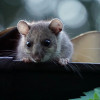Of the 1200 known bat species, 85% use sound to find their way around and to hunt; the other 15%, which are generally dubbed fruit bats, are regarded as non-echolocators that rely on vision for flying and foraging. But now new research from Israel suggests that this is a myth and these Old World fruit bats might actually echolocate after all, albeit in a more primitive way.
Indeed, the discovery may provide clues to the evolutionary origins of echolocation in the first place. Writing in Current Biology, Arjan Boonman and his colleagues from Tel Aviv University tested 3 different families of fruit bats to measure their ability to avoid obstacles in a tunnel.
The animals were tested in light and dark conditions to compare their performances and to see if they produced any sounds. Sensitive microphones picked up vollies of quiet "click" sounds. These sounds each lasted 1/3000'th of a second and ranged in frequency from the upper limits of what a human can hear (about 15kHz) to more than 70kHz. Critically, the bats are sensitive to sounds at these pitches, and the production of these sounds increased significantly - by up to seven-fold - when they flew in the dark.
Unlike their echolocating cousins, these fruit bats couldn't avoid small targets in the dark, like pieces of cable dangling from the roof, but they could locate large objects, like a board or sheet-covered perch, suggesting that the sounds do nonetheless help them to navigate under low-light conditions.
The researchers tried using white noise to drown out the sound of the bats' clicks to see whether this would impair their performance, but the bats refused to fly when the sounds were turned on. The Tel Aviv team don't know how the animals make the click sounds but, unlike echolocating bats which produce vocal cries, temporarily taping closed the mouths of the fruit bats didn't alter their ability to click.
High speed video footage of the animals flying, however, showed that the sounds are synchronised with the beating of the bat's wings. And masking tape stuck to the edge of a wing was sufficient to stop the clicks being emitted, suggesting that the animals use their wing tissue to make the sound somehow.
That three different distantly-related families of fruit bat use this technique argues that it is an evolutionarily old trait and the team speculate that this may be the way that echlocation in the animal world, which is far more widespread that just bats, got started...










Comments
Add a comment